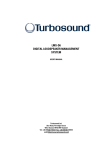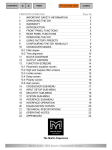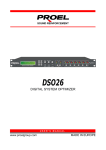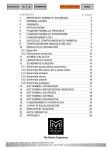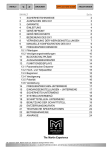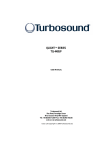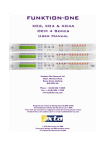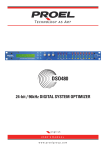Download TOA Electronics TDX2 Speaker User Manual
Transcript
TDX2 USER MANUAL 2 Tannoy TDX2 Quick reference To access a channel press the appropriate channel’s ‘GAIN’ button. When you press the button once you will get that channel’s gain screen. To scroll through a channels’ parameters, use the ‘BACK’ and ‘NEXT’ keys. (If you press the gain button a second time, you will get the last parameter viewed. A third press will take you back to the default screen.) To enter the menus, press the ‘MENU’ key. Use the ‘BACK’ and ‘NEXT’ keys to take you to the sub-menu you require. ‘ENTER’ will take you into the sub-menu you have selected. Use the ‘BACK’ and ‘NEXT’ keys to select the menu you require. Press ‘ENTER’ to take you into the menu selected. ‘BACK’ and ‘NEXT’ will then select the menu options. Use ‘ENTER’ to confirm selection. MENUS: X-over Sub-Menu: Used for storing and recalling X-overs including format, output EQ, output delay, output gain and limiter settings. Also used for designing a new Xover. Input Sub-Menu: Used for ganging inputs. Security Sub-Menu: Used for locking various features of the unit with a unique 4 digit code. System Sub-Menu: Used to view reports of the units status. Other options include whether the parameters are displayed in Q or bandwidth and if the meters are pre or post mute. Interface Sub-Menu AES/EBU Sub-Menu Notes: 1. The X-over (output) settings are stored / loaded independently (using ‘store / load a X-over’) from the input settings (using ‘store / load input memory’). 2. The output meters show level, in dB’s, from limiter threshold. The input meters show level, in dB’s, from input clip. 3. HPF’s and LPF’s are defined independently on each channel. 4. To get access to the limiter attack and release, select ‘Auto Limiter TC’ No, when designing a X-over 5. To show parametric filters in bandwidth (‘BW’), rather than Q, go into the ‘system sub-menu’, select ‘filter Q or BW’, select BW. 3 4 Contents Important Safety Information ................................................................................................. 7 1. Introduction ....................................................................................................................... 8 2. Unpacking the TDX2.......................................................................................................... 8 3. General Overview and Features........................................................................................ 8 3.1. Features...................................................................................................................... 8 4. Front Panel Functions ..................................................................................................... 10 5. Rear Panel Functions ...................................................................................................... 11 6. Operating the TDX2......................................................................................................... 12 6.1. Preliminary Set-up .................................................................................................... 12 6.2. Loading a factory preset............................................................................................ 12 6.3. Designing your own crossover................................................................................... 12 6.4. Menu Selections ....................................................................................................... 13 7. TDX2 Configurations ....................................................................................................... 14 7.1. Introduction ............................................................................................................... 14 7.2. Crossover Modes ...................................................................................................... 14 7.3. Filter slopes .............................................................................................................. 14 7.4. Time Alignment......................................................................................................... 14 7.5. Block Diagrams of X-Over modes ............................................................................. 16 7.6. Output Limiters ......................................................................................................... 19 8. Function Screens............................................................................................................. 20 8.1. Parametric Equaliser Screen..................................................................................... 20 8.2. High and Low pass filter Screens .............................................................................. 21 8.3. Limiter Screen........................................................................................................... 22 8.4. Delay Screen ............................................................................................................ 23 8.5. Polarity Screen ......................................................................................................... 23 8.6. Gain Screen.............................................................................................................. 24 9. Menu Options.................................................................................................................. 25 9.1. X-over Sub-Menu...................................................................................................... 25 9.2. Input Set-up Sub-Menu ............................................................................................. 25 9.3. Security Sub-Menu.................................................................................................... 25 9.4. System Sub-Menu..................................................................................................... 26 9.5. Interface Sub-Menu................................................................................................... 26 9.6. AES / EBU Sub-Menu ............................................................................................... 27 10. Equalisation Curves....................................................................................................... 28 11. Specifications ................................................................................................................ 30 12. Operating Notes ............................................................................................................ 31 12.1. Operating Level ...................................................................................................... 31 5 12.2. Grounding ............................................................................................................... 31 13. Warranty ....................................................................................................................... 32 14. Appendices.................................................................................................................... 33 14.1. Appendix 1 : Limiter threshold................................................................................. 33 14.2. Appendix 2: Default Xover Settings......................................................................... 34 6 An example of this equipment has been tested and found to comply with the following European and international Standards for Electromagnetic Compatibility and Electrical Safety: Radiated Emissions (EU): EN55013-1 (1996) RF Immunity (EU): EN55103-2 (1996) RF Immunity, ESD, Burst Transient, Surge, Dips &Dwels Electrical Safety (EU): EN60065 (1993) Important Safety Information Do not remove Covers. No user serviceable parts inside, refer servicing to qualified service personnel. This equipment must be earthed. CAUTION RISK OF ELECTRIC SHOCK DO NOT OPEN DO NOT EXPOSE TO RAIN OR MOISTURE ATTENTION RISQUE DE CHOC ELECTRIQUE NE PAS ENLEVER NE PAS EXPOSER A LA PLUIE NI A L’HUMITE It should not be necessary to remove any protective earth or signal cable shield connections. Do not defeat the purpose of the polarized or grounding-type plug. A polarized plug has two blades with one wider than the other. A grounding type plug has two blades and a third grounding prong. The wider blade and the third prong are provided for your safety. When the provided plug does not fit into your outlet, consult an electrician for replacement of the obsolete outlet. Only use this equipment with an appropriate mains cord. In the USA the cord should comply with the requirements contained in the Standard for Cord Sets and Power Supply Cords, UL 817, be marked VW-1, and have an ampacity rating not less than the marked rating of the apparatus. 7 1. Introduction Thank you for choosing the Tannoy TDX2 loudspeaker system controller for your application. The TDX2 is an advanced digital electronic controller intended to optimise the performance of Tannoy loudspeaker systems. This manual explains how to configure the TDX2 to be tailored to your specific application. As well as technical specifications it also contains some helpful advice on how to use this controller and how to obtain the best possible performance from this unit. Please spare a little time to read the contents of this manual so that you obtain the best possible performance from this unit. 2. Unpacking the TDX2 Before your TDX2 Digital Controller left the factory, it was inspected and tested to make sure it reaches you in perfect condition. Would you please, however, check your TDX2 to make sure no damage has occurred in transit. In the unlikely event of any damage, would you please notify your dealer immediately and retain your shipping carton, as your dealer may ask you to return the faulty unit to him for inspection. 3. General Overview and Features The TDX2 is a compact and powerful DSP based audio-processing unit, ideally suited for live applications, where it combines the functions of multiple conventional products in a compact 1U high unit. For ease of use, the TDX2 is factory set for operation with Tannoy products. In addition to this, 19 user memories are available. The latest preset files and Tannoy parameters can be obtained from your distributor or from the Tannoy website www.tannoy.com. The TDX2 has 2 inputs and 6 outputs, which can be configured in 5 basic modes, 2 x 2 way, 2 x 3 way, 4 way, 5 way and 6 way crossover. Each input has gain and delay and each output consists of a high and low pass filter, 5 bands of parametric equalisation, limiter, delay, gain and polarity controls. A multi-level security ‘lockout’ function is available for these controls. The TDX2 is also available with optional AES/EBU inputs and outputs. The TDX2 is designed for quick adjustment via easy-to-use front panel controls. 3.1. Features • • • 8 Superb audio quality: Carefully optimised Double Precision processing plus 40 bit internal data path for exceptional dynamic range and sonic quality. A flexible 2 input, 6 output multi-mode format featuring a choice of 2 x 2 way, 2 x 3 way, 4 way, 5 way and 6 way crossover modes with limiters. Each parametric section provides +15dB to -30dB of gain at centre frequencies between 20Hz - 20kHz with a wide range of Qs from 0.4 to 128. All parameters feature fine resolution with 1/36th octave frequency steps, 0.1dB gain increments and 100 Q settings. Any parametric section can be set for LF & HF shelving response. • • • • • • • Six high performance limiters are provided, featuring a wide range of control over Attack, Release and Threshold parameters. The output meters shows headroom to the limit threshold. The meter time constants track the limiter time constants to show precise power usage. Variable High and Low pass filters for each output can be set for 12, 18 and 24dB per octave slopes with a choice of Bessel, Butterworth or Linkwitz-Riley responses. Independent control over High & Low pass functions allows asymmetric crossover functions to be realised. Three velocity-sensitive rotary encoders provide a familiar and easy to use control format with all filter information displayed simultaneously on a backlit LCD display. Delay of up to 650mS can be independently set for each output with a minimum increment of 2.6µS. Comprehensive standard specification includes 19 user memories and Tannoy preset memories. The TDX2 provides exceptional audio quality with a full >110dB dynamic range, high sampling rate and minimal filtering. AES / EBU digital inputs and outputs are available as an option. 9 4. Front Panel Functions 1. LCD Display - Shows menu options, output information and various parameters being adjusted. 2. Gain Keys - Two input and six-output ‘gain’ keys allow instant access to the gain screen for each channel. When a channel is selected the accompanying LED lights up. Pressing a second time selects the last function edited. 3. Next Key - Moves the display forwards through the list of available parameters for the current input or output channel. 4. Back Key - Moves the display backwards through the list of available parameters for the current input or output channel. 5. Menu Key - Activates the main menu on the LCD display. Pressing a second time selects the last menu edited. Different menus are selected by pressing the ‘BACK’ and ‘NEXT’ keys or using the ‘FREQ’ control. 6. Enter Key - Enters the chosen menu and confirms menu selections. 7. Quit Key - Exits the menu. 8. Bypass Key - Allows the currently displayed parametric section to be bypassed. (Note: The High pass / Low pass filters and limiters can not be bypassed.) 9. Parameter Controls - The three velocity sensitive rotary encoders allow the relevant parameter, on the LCD screen, to be adjusted. 10. Input Meters - Displays available headroom before input clipping occurs. The bottom 2 LEDs (green and yellow) are set at -24dB and -6dB below clipping. The top, red LED displays digital overflow and can therefore light without all the other LEDs becoming illuminated. 11. Output Meters - Displays headroom before limiting occurs. The bottom two LEDs display between -24dB and -6dB of input headroom. The top, red LED indicates 4dB of limiting. 12. Mute Keys – Six output mute keys with LED indicator. 10 5. Rear Panel Functions 1. Power Switch. 2. Mains Fuse - Located in a finger-proof fuse holder adjacent to the mains inlet. Always replace this fuse with the correct type as shown on the rear panel legend. (N.B. A spare fuse is located in this holder.) 3. Mains Power - Connected via a standard IEC socket. A compatible power cord is supplied with the unit. 4. External - RS232 via a 9-pin DIN DEE socket, for connection to a PC. 5. XLR Inputs and Outputs - 3 pin XLR connectors are provided for each audio input and output. All terminations are fully balanced, pin 2 Hot, pin 3 Cold and pin 1 Screen (shield). 11 6. Operating the TDX2 6.1. Preliminary Set-up The following procedure should be followed when first installing the TDX2. Connect the unit to a mains outlet with the mains cable provided, via the IEC connector located on the back of the unit. The unit is switched on by flicking the power switch. The unit will take several seconds to load. The menu is accessed by pressing the ‘MENU’ key. The relevant sub-menus are selected by using the ‘BACK’, ‘NEXT’ and ‘ENTER’ keys as described in the sections below. 6.2. Loading a factory preset. Press ‘MENU’ and use the ‘BACK’ and ‘NEXT’ keys to select ‘Xover’ on the screen. Press ‘ENTER’. Display ‘Load a Xover’ using the ‘BACK’ and ‘NEXT’ keys, and press ‘ENTER’ to select. Select the desired crossover by pressing ‘BACK’ and ‘NEXT’ keys. Once the desired crossover is displayed, press ‘ENTER’. The crossover will load automatically. 6.3. Designing your own crossover. Press ‘MENU’ and use the ‘BACK’ and ‘NEXT’ keys to select ‘Xover sub-menu’ on the screen. Press ‘ENTER’. Use the ‘BACK’ and ‘NEXT’ keys to select ‘Design a Xover’, then press ‘Enter’ to select. Follow the set-up wizard to design your crossover. The menu functions will be explained in the Section 9. When in a menu use the ‘BACK’ and ‘NEXT’ keys to display menu options. When the required menu is shown, press ‘ENTER’ to confirm selection. The current selection will be marked by a ‘ * ’ star. To program each individual channel, press the ‘GAIN’ button on the relevant channel. The channel data will then be displayed. Use the ‘BACK’ ,‘NEXT’, ‘ENTER’, ‘FREQ’, ‘Q’ and ‘GAIN’ keys to select HPF, LPF, parameters etc. See Section 8 for more information on Function screens. When designing a new crossover the HP and LP filters will be set to their defaults, see appendix 2. If no action is taken in the menu mode the unit will return to normal 'default' mode. Repeat above instructions to return to menu mode. 12 6.4. Menu Selections The following menu selections are available. To access menus, see instructions under preliminary set-up above. Xover Sub-Menu: Load a Xover: Loads a pre-defined crossover. Design a Xover: Set-up wizard for designing a crossover. Store a Xover: Stores all output settings as a defined crossover. Erase a Xover Mem: Erases a Xover from the list Input Set-up Sub-Menu: Allows ganging of inputs. Security Sub-Menu: Locks the unit with a unique user defined 4 digit code. 4 options are available: changes only, changes + view, changes + mutes, everything. Caution: Do not enter this menu option before reading and understanding the instructions in section 9.4, Security Sub-menu on page 24. System Sub-Menu: System Status: Displays unit information including software version and temperature. LCD Contrast: Adjusts LCD contrast. LED Brightness: Adjusts LED brightness. Temperature Alarm: Sets a temperature warning value in Centigrade. Wake-up Time: Sets the unit wake-up time and whether or not the unit starts up in mute. Output Meters: Selects output meters to be pre or post mute. Filter Q or BW: Selects whether Q or bandwidth is displayed in the parametric screens. Delay Time/Distance: Selects whether delay is set in time in ms or distance in metres. Interface Sub-Menu: External Mode: Selects baud rate. AES / EBU Sub-Menu: Routing options: Selects various routing options if installed. AES diagnostics: Shows the complete status of the input AES signal. Available only if the AES option is fitted. (For more in-depth information on menu functions, refer to Section 9 page 25.) 13 7. TDX2 Configurations 7.1. Introduction To simplify set-up of the TDX2, 5 crossover modes are menu selectable. These all have parametric equalisers, high and low pass filters, limiters, gain and delay. For detailed information on these modes please study the block diagrams along with the following descriptions. 2 x 3 way and 2 x 2 way crossover modes have the option available to provide precise 'ganged' parameter adjustment for stereo sources. 7.2. Crossover Modes Please see block diagram. All crossover modes feature adjustable crossover frequencies with a choice of slopes, 5 bands of driver compensation E.Q. per output and delay time plus limiters for each output. Phase reverse is provided for each output. 7.3. Filter slopes A choice of Bessel or Butterworth slopes at 12/18/24dB per octave and LinkwitzRiley at 24dB per octave are provided. Since Low and High pass functions are separately adjusted, asymmetric slopes are easily achieved, if required. It should also be noted that the turnover frequency displayed on the TDX2 is the -3dB point for all slopes except 24dB Linkwitz-Riley where the -6dB point is shown. If the -6dB point is to be used for the Bessel or Butterworth filter, take the required crossover frequency, multiply this by the appropriate factor from the following table and then select the closest available frequency on the TDX2’s display. Filter Type High pass filter factors Low pass filter factors Bessel 12dB/octave 1.45 0.69 Butterworth 12dB/octave 1.31 0.76 Bessel 18dB/octave 1.37 0.73 Butterworth 18dB/octave 1.19 0.84 Bessel 24dB/octave 1.35 0.74 Butterworth 24dB/octave 1.15 0.87 Please note that unlike conventional analogue crossovers, crossover points and slopes are set with absolute accuracy since component tolerance problems do not occur. 7.4. Time Alignment A further advantage of the TDX2 over conventional products is the provision of an independently adjustable delay section for each output. This allows the true arrival time from multiple drivers to be aligned precisely rather than relying on the compromise 'phase adjust' approach. Delay time can be input in either time or 14 distance (System Sub-menu) and is adjustable in 2.6µS steps (1mm), or in 0.8mm (or 0.003 feet) steps. Alternatively, to convert from units of time (i.e. milliseconds) to units of distance use the following formula, or change the input method in ‘delay time/distance’ in the System Sub-Menu. 1 millisecond = 343mm (1.126ft) @ 20°C (68°F) or to calculate time delay for a known distance, use: Time delay = Distance in meters 20.06 x √(273+°C) Were °C is the temperature in °C. Or to simplify this equation at 20°C. Delay time in milliseconds = Distance in meters x 2.192. Or delay time in milliseconds = Distance in feet x 0.955 (N.B. Centigrade = (Fahrenheit –32) x 0.5555. 15 7.5. Block Diagrams of X-Over modes Tannoy TDX2 2×2 Way + 2 × Mono Sum X-Over Tannoy TDX2 2×3 Way X-Over 16 Tannoy TDX2 4 Way + 2 X-Over Tannoy TDX2 5 Way + 1 X-Over 17 Tannoy TDX2 6 Way X-Over 18 7.6. Output Limiters High performance digital limiters are provided for each output with control over attack time, release time and threshold level parameters (see Section 8.2, page 22). This level of control allows the user to balance the required subjective quality of the limiter against the driver protection requirements. It also means that an incorrectly set limiter may sound awful! In particular, as with all limiters, using too fast an attack or release time will result in excessive low frequency distortion. In ‘design a crossover’ sub-menu there is an option for automatic limiter time constants. In this mode the time constants will be automatically set from the High pass filter frequency. See table below. 7.7. Table of automatic attack and release times. The time constants are set by the high pass filter frequency for that channel. High pass filter Auto attack time Release <10Hz – 31Hz 45mS x16 (720mS) 31Hz – 63Hz 16mS x16 (256mS) 63Hz – 125Hz 8mS x16 (128mS) 125Hz – 250Hz 4mS x16 (64mS) 250Hz – 500Hz 2mS x16 (32mS) 500Hz - 1kHz 1mS x16 (16mS) 1kHz – 2kHz 0.5mS x16 (8mS) 2kHz – 22kHz 0.3mS x16 (4mS) 19 8. Function Screens 8.1. Parametric Equaliser Screen OP1+4 1K00Hz Low PEQ: 1 Ο B=.34 0.0dB All modes feature a total of 30 bands of fully flexible parametric equalisation (5 per output), with all sections selectable to Low or High frequency shelving response. Each parametric section can be positioned at a frequency from 20Hz to 20kHz and features a wide range of 'Qs’ to produce response curves ranging from broad to notch. The gain control ranges from +15dB to -30dB in 0.1dB steps. Frequency steps are in 1/36 octave resolution for precise control. Since all filtering is achieved in DSP, all settings are re-settable with absolute accuracy and in ganged mode parameters track identically. Very narrow band notch filters (maximum Q of 128) can be achieved and unlike analogue filters these 'tight' Q filters are entirely stable. The maximum notch depth is -30dB. Parametric filters are carefully implemented using Double Precision processing. This method is costly in terms of processing power but yields substantial benefits in terms of the TDX2’s exceptional noise performance and greatly improved low frequency stability. To adjust parametric settings: Select relevant channel by pressing the channel ‘GAIN’ button. Use the ‘BACK’ and ‘NEXT’ keys to select relevant parameter screen. Use the ‘FREQ’ control to adjust the frequency. Use the ‘Q’ control to adjust Q. Use the ‘GAIN’ control to adjust the gain. (N.B. To show parametric filters in bandwidth (BW) rather than Q, go into the ‘system sub-menu’, select ’filter Q or BW’, select BW.) 20 8.2. High and Low pass filter Screens OP1+4 < 10Hz Low Bessel HPF 24dB Each output has an independent high pass filter and an independent low pass filter. Both filters have a range of selectable slopes, which are Bessel 12dB, 18dB and 24dB, Butterworth 12dB, 18dB and 24dB, and Linkwitz-Riley 24dB. High pass filters have a range of <10Hz (through) to 16kHz and Low pass filters have a range of 22kHz (through) to 35.1Hz in 1/36 octave steps. HPFs and LPFs can be asymmetrical set. To adjust HPF/LPF settings: Select relevant channel by pressing the channel ‘GAIN’ button. Use the ‘BACK’ and ‘NEXT’ keys to select HPF and LPF screens. Use the ‘FREQ’ control to adjust the frequency. Use the ‘Q’ control to select the slope. Note: The low pass filter frequency cannot be set lower than the high pass filter frequency and vice versa. 21 8.3. Limiter Screen OP2+5 Mid Limiter Atk:4.0mS Rx16 +22dB Each output has an independent high performance limiter. All limiters have an attack range of 0.3mS to 90mS, release times are 4, 8, 16 and 32 times the attack time and thresholds range from +22dB to –10dB in 1dB steps. If the automatic limiter time constant option is in use, all limiter screens will say ‘automatic’ and the time constants will be set from the High pass filter frequency. A table of dB to Vrms is in appendix 1. The output meters are linked to the time constants of the limiters so true output metering is achieved. To adjust the limiter settings: Select relevant channel by pressing the channel ‘GAIN’ button. Use the ‘BACK’ and ‘NEXT’ keys to select the limiter screen. Use the ‘FREQ’ control to adjust the attack time. Use the ’Q’ control to adjust the release time. Use the ‘GAIN’ control to adjust the limiter threshold. 22 8.4. Delay Screen OP1 Low Delay = 1.003mS Each output has an independent delay time control. This can be adjusted in 2.6µs steps and in 1ms steps giving complete control over driver time alignment. Input delay (base delay) is adjustable in 1ms steps only. To adjust the delay settings: Select relevant channel by pressing the channel ‘GAIN’ button. Use the ‘BACK’ and ‘NEXT’ keys to select the delay screen. Use the ‘FREQ’ control for coarse control. (1mS steps) Use the ‘Q’ control for fine control. (2.6µS steps) (N.B. To show delay in distance (mm or feet) rather than time, go into the ‘system sub-menu’, select ’DelayTime/Distance’, select ‘Metres’ or ‘Feet’.) 8.5. Polarity Screen OP1 Low Polarity = [ + ] Each output has an independent polarity screen. This gives the flexibility to reverse the phase of individual outputs (rotate by 180°). (N.B. When the outputs are ganged, the polarity screens remain individual.) To adjust the polarity: Select relevant channel by pressing the channel ‘GAIN’ button. Use the ‘BACK’ and ‘NEXT’ keys to select the polarity screen. Use the ‘GAIN’ control to toggle between + and -. 23 8.6. Gain Screen O/P1+3 LOW Gain = 0.1dB Each output and input has an individual gain screen. The outputs have a range of +15dB to –40dB, adjustable in 0.1dB steps and the inputs have a range of +6dB to –40dB, again adjustable in 0.1dB steps. To adjust the gain: Select relevant channel by pressing the channel ‘GAIN’ button. Use the ‘BACK’ and ‘NEXT’ keys to select the gain screen. Use the ‘GAIN’ control to adjust the gain in dB. 24 9. Menu Options 9.1. X-over Sub-Menu Press 'MENU' and select X-over Sub-menu using the ‘BACK’, ‘NEXT’ and 'ENTER' keys. Four options are available in this sub-menu which are: Load a Xover : Loads a stored crossover. This includes factory preset files. Updates can be obtained from your distributor or from the Tannoy website, www.tannoy.com Design a Xover: Opens a wizard to design a crossover. Options include format type, ganging of outputs, routing and automatic limiter time constants. Store a Xover: Stores a X-over (all output settings) to one of 19 user memories. Crossovers can be named with a user defined name of up to 16 characters which will be displayed on the default screen. To do this, select the memory number by using the ‘FREQ’ and ‘ENTER’ keys, and enter the name by using the ‘FREQ’ to select a character and the ‘BACK’ and ‘NEXT’ keys to move to scroll between the characters. Press ‘ENTER’ to confirm the X-over name. Erase a Xover Mem: Erases a selected X-Over from memory. 9.2. Input Set-up Sub-Menu Press ‘MENU' and select ‘Input’ Sub-menu using the ‘BACK’ and ‘NEXT’ keys. Press ‘ENTER’ to confirm. There is only ‘Gang Inputs’ in this menu. This gangs A and B inputs so that precise adjustments can be made to both inputs simultaneously. 9.3. Security Sub-Menu Press 'MENU' and select Security Sub-menu using the ‘BACK’, ‘NEXT’ and 'ENTER' keys. Press 'ENTER' to load one of the four selections. (See below) A four-digit security code will then be asked for. This can be entered by using the ‘FREQ’ control, to select a character, and the ‘BACK’ and ‘NEXT’ keys to move to the next character. Additionally, the ‘GAIN’ keys can be used to enter a code by pressing any combination of the eight buttons. Each ‘GAIN’ key represents its channel labelling, so any combination of A, B, 1, 2, 3, 4, 5 and 6 can be used as a code. The is entered twice, for confirmation. Lock options: User Specific: This option locks parameters specified by the user, including gains, delays, PEQs, limiters, HP & LP filters, phase, trim mute, as well as menu system and memory store and recall. Xover Only: This option locks all the crossover parameters, except trim and mute. Xover + Trim: This option locks all the crossover parameters, except mute. Xover + Trim + Mute: This option locks all crossover parameters, including mute. Changes only: This option locks all parameters so that no changes can be made, 25 including all menus. Changes + view: This option locks all parameters and the viewing of them on the LCD including all menus. Changes + mutes: This option locks all parameters, including all menus, and disables all mute keys. Everything: This option locks all parameters and the viewing of them, including all menus, and disables all mute keys. To 'unlock' the security system, press the 'MENU' key and enter correct code. IMPORTANT - Please Note that once the security system is initiated only reentering the correct code will 'unlock' the TDX2s’ functions. Please note the code! If the security code number is inadvertently lost contact your local Tannoy sales office. 9.4. System Sub-Menu Press 'MENU' and select X-over Sub-menu using the ‘BACK’, ‘NEXT’ and 'ENTER' keys. Several options are available in this sub-menu: System Status: Displays unit information including software version and temperature. Curr. Temp. = current temperature in degrees Celsius. Max1. Temp. = maximum temperature this session. Max2. Temp. = maximum temperature ever reached. LCD Contrast: Adjusts the LCD contrast from 0 to 100. LED Brightness: Adjusts the LED brightness from 1 to 15. Temperature Alarm: Sets a temperature warning between 20 and 80°C. The default screen will flash ‘ALARM. Temp = n°C’ when the specified temperature is reached. (N.B. the warning does not affect the units’ performance in any respect.) Wake-up Time: Sets how the unit starts up with one of the following options. 0 to 60 seconds: Waits the specified time before unit wakes up. Mute hold: Turns on and holds all output mutes when turned on. (N.B. Wake-up is a slow ramp in level for about 5 seconds.) Output Meters: Selects whether the output meters are pre or post mute. Filter Q or BW: Selects whether ‘Q’ or Bandwidth is displayed in the parametric screens. Delay Time / Distance: Selects whether time delay is displayed in time (ms), distance (metres or feet). 9.5. Interface Sub-Menu Press 'MENU' and select X-over Sub-menu using the ‘BACK’, ‘NEXT’ and 'ENTER' keys. Interface Set-up: Opens a wizard to configure the remote interface. This allows for the RS232 Baud rate to be adjusted to one of the following values: 2400, 4800, 9600, 19200 or 38400. (This should correspond to the Baud rate on the computer 26 when downloading new presets). 9.6. AES / EBU Sub-Menu Connection of AES/EBU signals is via the existing rear panel XLR connectors. Menu Selections: With the AES/EBU option fitted, AES Receive and Diagnostic modes are provided. 27 10. Equalisation Curves Figure 1 - Parametric filter gain curves. Figure 2 - Parametric filter 'Q' curves. Figure 3 - Parametric filter High and Low shelf curves. 28 Figure 4 - High pass filter curves. Figure 5 - Low pass filter curves. Figure 6 - Parametric filter with high 'Q' to achieve notch response. 29 11. Specifications Inputs Impedance CMRR Two electronically balanced. u > 10k ohms. >65dB 50Hz - 10kHz. Outputs Source Imp Min. Load Max. Level Six electronically balanced. u < 60ohms. 600ohm. +20dBm into 600 ohm load. Frequency Resp. Dynamic Range Distortion Maximum Delay Output gain Input gain ±0.5dB 20Hz - 20kHz. >110dB 20Hz -20kHz. Unwtd. < 0.02% @ 1kHz, +18dBm. 650 mS. (Increment 2.6 µS) adjustable +15dB to -40dB in 0.1dB steps and mute. Adjustable +6dB to -40dB in 0.1dB steps. Parametric Equalisation Filters 5 Sections per output Filter gain +15dB to -30dB in 0.1dB steps. Centre frequency 20Hz - 20kHz, 1/36 octave steps. (368 positions) Filter Q / BW 0.4 to 128 / 2.5 to 0.008 (Sections switched to shelving response) Low frequency 20Hz - 1kHz High frequency 1kHz - 20kHz Shelf gains ±15dB in 0.1dB steps. High and Low pass Filters Filters 1 of each per output. Frequency (HPF) 10Hz - 16kHz, 1/36 octave steps. Frequency (LPF) 60Hz - 22kHz, 1/36 octave steps. Response Bessel / Butterworth 12/18/24dB per octave and Linkwitz-Riley 24dB per octave. Limiters Threshold +22dBu to -10dBu. Attack time 0.3 to 90 milliseconds. Release time 4, 8, 16 or 32 times the attack time. Display Input meter Output meter Connectors Inputs Outputs External RS485 Power Power Consumption Weight Size Optional Interfaces Options 2 x 20 character backlit LCD. 2 x 3 point, -24dB to digital clip. 6 x 3 point, -24dB to +4dB into limit. 3 pin female XLR. 3 pin male XLR. 9 pin DEE connector (RS232) 3 pin male XLR (out.) 3 pin male XLR (in.) 3 pin IEC. 60 to 250V ±15% @ 50/60Hz. < 20 watts. 3.5kg. Net (4.8kg. Shipping) 1.75"(1U) * 19" * 11.8" (44 * 482 * 300mm) excluding connectors. Radio link. u = Transformers available. Due to continuing product improvement the above specifications are subject to change. 30 12. Operating Notes 12.1. Operating Level With any audio signal processing equipment it is necessary to ensure adequate signal level is used through the device, to avoid sacrificing noise performance. The TDX2 features a menu selectable choice of operating levels to reduce this problem (see section 8.6) It is suggested that the operating level chosen should give adequate level to just light the -6dB LED on the headroom meter with maximum program level being used. Since the meter is deliberately set to 'over-read' by 3dB, this still provides 9dB of headroom before clipping occurs. With equalisation in use it may be necessary to further reduce the input level, as gain within the unit may cause digital clipping, indicated by the top red LED's lighting. It should be noted that the figure quoted for the maximum input level options is the clipping point for that option (not a safe operating level). Always ensure that this clipping point is no lower than that for the following equipment in the signal chain, and allow extra margin if equalisation sections are boosted. 12.2. Grounding The Screen (shield) pins on all audio connectors are normally connected directly to the ground pin of the IEC mains inlet. The chassis is also directly connected to this pin. Never operate this unit without the mains safety ground connected. Signal ground (0V) is in turn connected to the chassis ground. To avoid ground loops, cable shields should be connected to ground at one end only. The normal convention is that the shield is only connected at the output XLR. Provision is also made for separately isolating each input and output shield pin permanently within the TDX2 by breaking the appropriate PCB track, where marked with a box and an arrow next to each XLR connector using a small drill bit or cutter. See the following diagram for details. Figure 7 - XLR pin 1 Isolation points and 10dB pads 31 13. Warranty No maintenance of the TDX2 is required. If servicing is required, it must only be carried out by qualified personnel. Do not remove the top cover, as there may be a risk of electric shock. All Tannoy electronic components are guaranteed for a period of one year from the date of shipment, subject to the absence of, or evidence of, misuse, overload or accidental damage. For further information please contact your dealer or the distributor in your country. If you cannot locate your distributor please contact: Customer Services Tannoy Ltd. Professional Division Rosehall Industrial Estate Coatbridge Strathclyde ML5 4TF Scotland Telephone: Fax: Email : +44 (0)1236 420 199 +44 (0)1236 428 230 [email protected] DO NOT SHIP ANY PRODUCT TO TANNOY WITHOUT PREVIOUS AUTHORISATION This warranty in no way affects your statutory rights. 32 14. Appendices 14.1. Appendix 1 : Limiter threshold Limiter threshold in dB to Vrms lookup table. dB Vrms dB Vrms +22 9.75 +5 1.38 +21 8.69 +4 1.23 +20 7.75 +3 1.09 +19 6.90 +2 0.98 +18 6.15 +1 0.87 +17 5.48 0 0.77 +16 4.89 -1 0.69 +15 4.36 -2 0.62 +14 3.88 -3 0.55 +13 3.46 -4 0.49 +12 3.08 -5 0.44 +11 2.75 -6 0.39 +10 2.45 -7 0.35 +9 2.18 -8 0.31 +8 1.95 -9 0.27 +7 1.73 -10 0.24 +6 1.55 Calculation: Vrms = 0.7746 x 10 ^ (dBu / 20) 33 14.2. Appendix 2: Default Xover Settings Default X-over settings and names for all formats. X-over 2x2 way+Ms Output 1 Output 2 Output 3 Output 4 Output 5 Output 6 Low High Low High Msub Aux 120Hz – 1k82Hz 1k82Hz – 22kHz 120Hz – 1k82Hz 1k82Hz – 22kHz 24.8Hz – 120Hz <10Hz – 22kHz 2 x 3 way Low Mid High Low Mid High 22.1Hz – 120Hz 120Hz – 1k82Hz 1k82Hz – 22kHz 22.1Hz – 120Hz 120Hz – 1k82Hz 1k82Hz – 22kHz 4 way + 2 Low LoMid HiMid 15Hz – 149Hz 149Hz – 1k31Hz 1k31Hz – 8kHz 5 way + 1 Sub Low LoMid High 8kHz – 22kHz HiMid 15Hz – 80.3Hz 80.3Hz – 180Hz 180Hz – 1k31Hz 1k31Hz – 8kHz 6 way LoSub Sub Low 15Hz – 80.3Hz 80.3Hz – 149Hz 149Hz – 1kHz Note: All filters set to 24dB Linkwitz-Riley. 34 LoMid 1kHz – 4kHz Aux Aux 20.1Hz – 22kHz 20.1Hz – 22kHz High Aux 8kHz – 22kHz 20.1Hz – 22kHz HiMid High 4kHz – 10k1Hz 10k1Hz – 22kHz 35 Tannoy Preset Parameters and the latest downloadable preset files are available from your Tannoy distributor or from our website: www.tannoy.com Tannoy Limited, Professional Division, Coatbridge, Strathclyde, ML5 4TF, Scotland. Tel: +44 (0) 1236 420199 Fax +44 (0) 1236 428230 e-mail: [email protected] Website: www.tannoy.com Tannoy / TGI North America Inc., 335 Gage Avenue, Suite 1, Kitchener, Ontario, Canada N2M 5E1. Tel: (519) 745-1158 Fax: (519) 745-2364 e-mail: [email protected] or [email protected] Website: www.tannoy.com Tannoy Nederland b.v., Anthonetta Kuijlstraat 19, 3066 GS Rotterdam. Tel: (010) 286 0554 Fax: (010) 286 0431 e-mail: [email protected] Website: www.tannoy.nl Tannoy is a member of the ML 6th December, 2000 36 Group of Companies




































